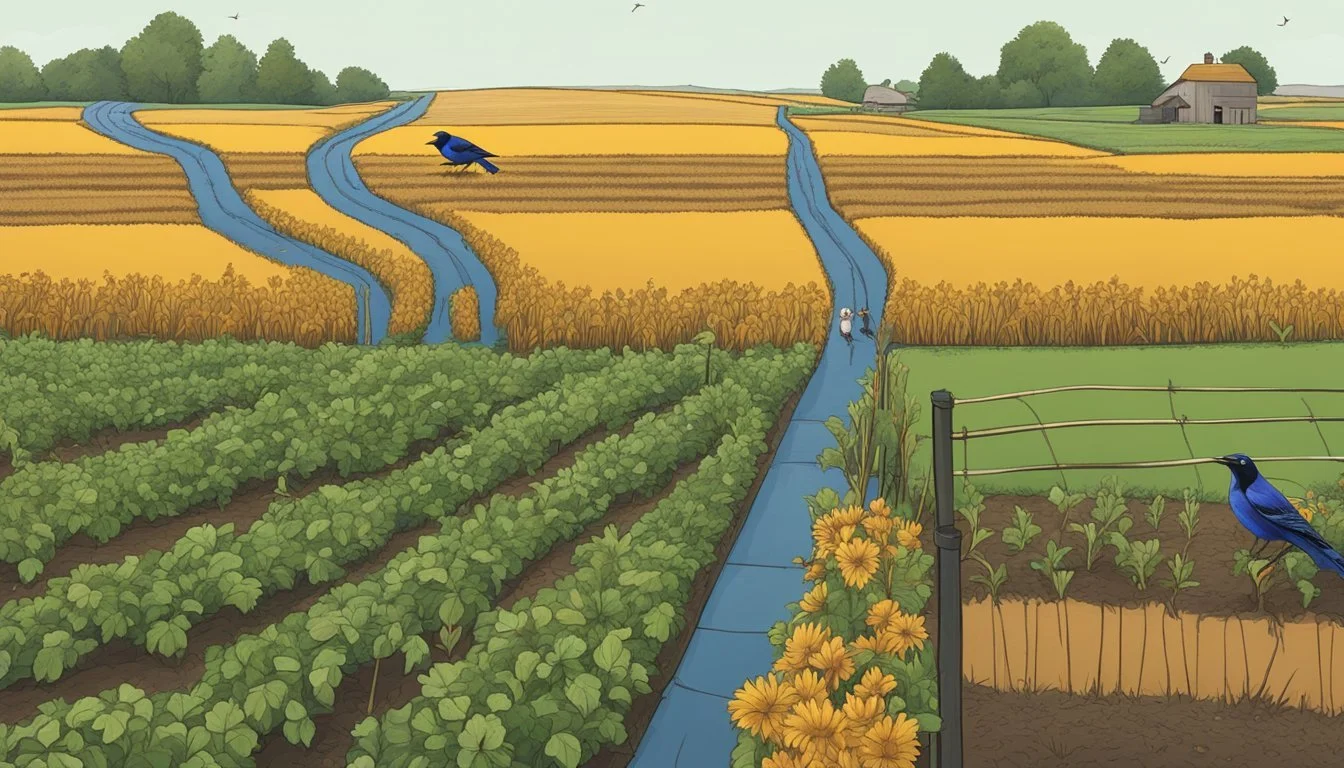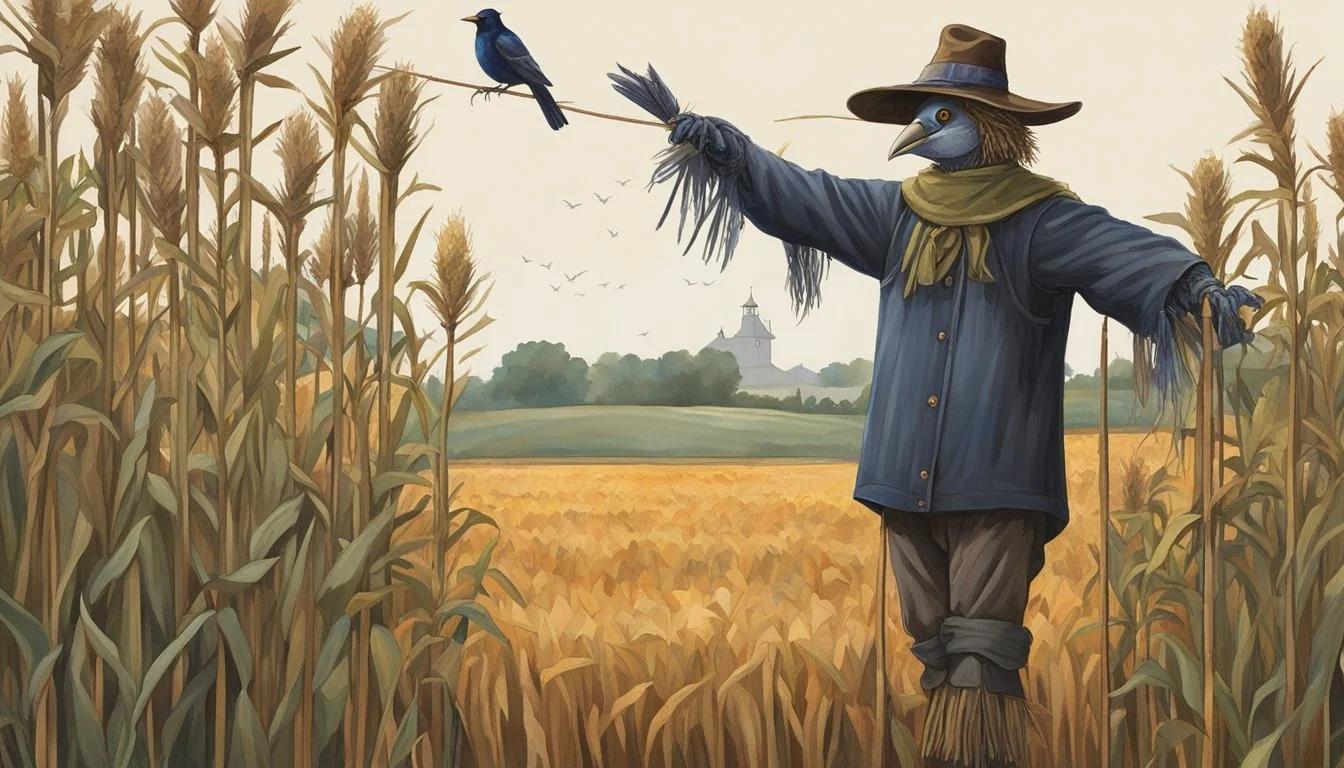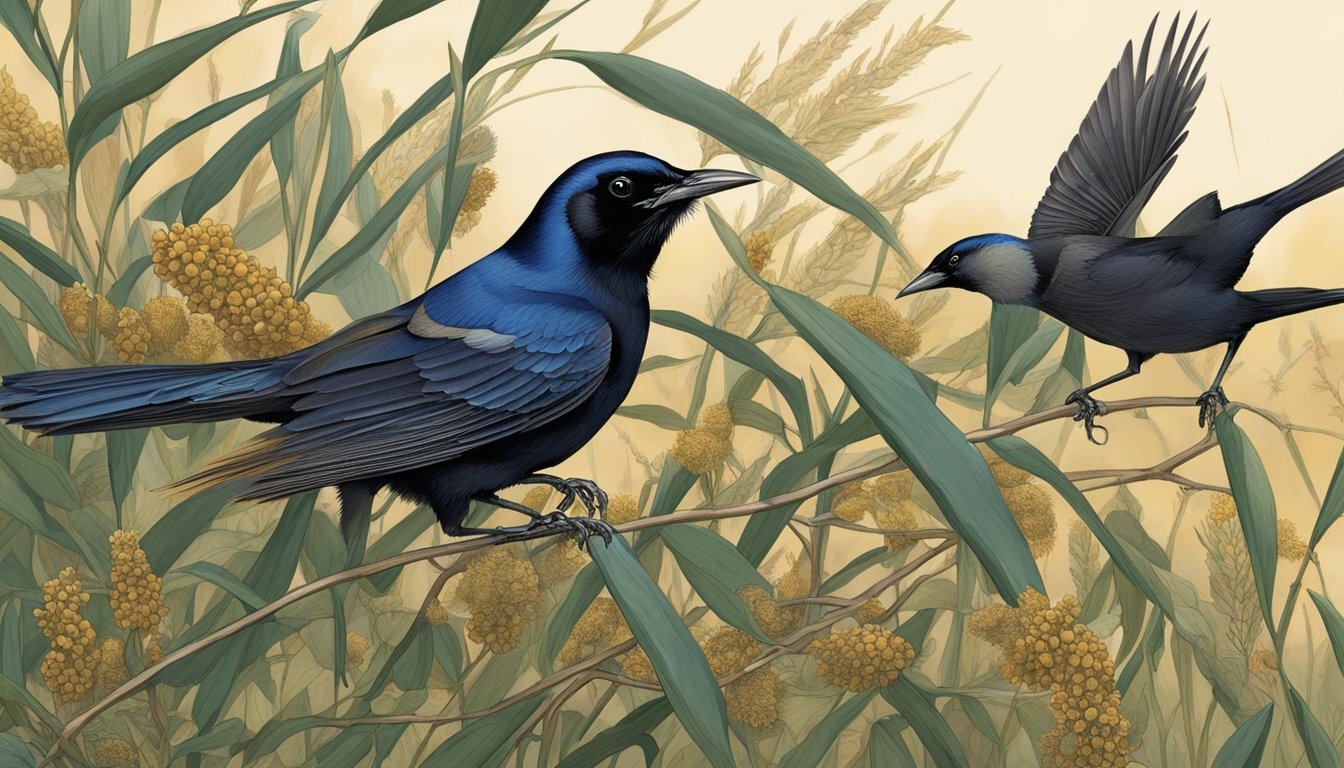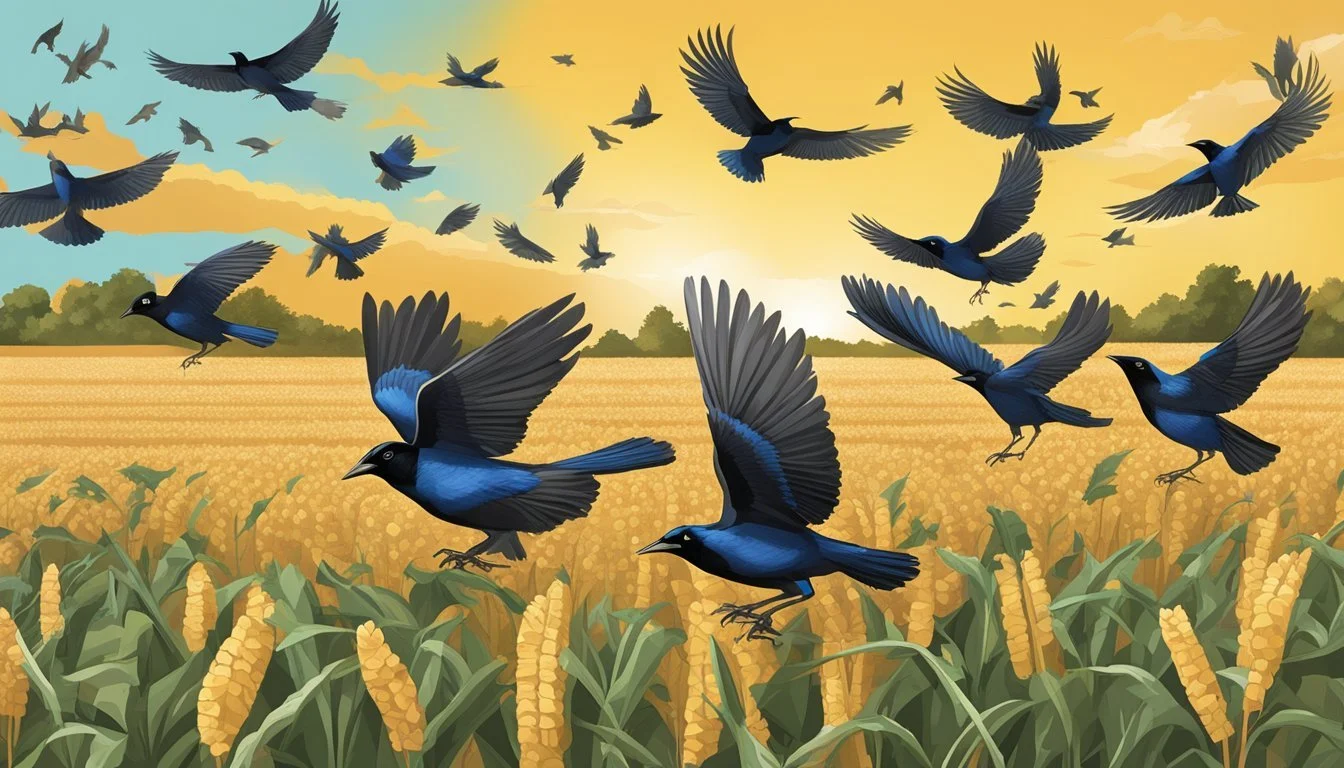Protecting Crops from Common Grackle
Effective Strategies for Farmers
Protecting agricultural produce from bird damage is an ongoing challenge for farmers and gardeners, and the common grackle is a bird species often at the center of such conflicts. With their iridescent black plumage and keen adaptability, common grackles are skilled foragers that can cause significant damage to crops. Their tendency to feed in large flocks means that they can descend on fields and orchards en masse, consuming or damaging fruits and grain crops such as corn, blueberries, and cherries.
Effective deterrent strategies are essential to safeguard the yield and maintain the balance with local wildlife. Various methods have been developed to minimize the impact of grackles on agriculture without harming the birds themselves. From employing visual and auditory scare tactics to installing protective netting and utilizing non-toxic chemical repellents, there is a range of tools available that can help farmers and gardeners protect their crops. Implementing these measures early and consistently can make a substantial difference in crop conservation and can deter grackles from establishing feeding habits in cultivated areas.
Understanding the Common Grackle
The Common Grackle is a species of blackbird that is prevalent across North America, known for its distinctive appearance and adaptability. This bird's habits, especially its feeding behavior, can have significant impacts on agriculture.
Species Overview
The Common Grackle, Quiscalus quiscula, is part of the Icteridae family, which places it among various other blackbird species. They are native to North America and exhibit a remarkable ability to thrive in a range of environments, which has led to their widespread presence across the continent.
Physical Characteristics
Adult Common Grackles are identifiable by their size and shape; they possess long, keel-shaped tails and sharp, pointed bills. In terms of color, males often exhibit glossy black plumage with hints of iridescence, while females feature a more subdued brownish tone. Their striking yellow eyes set them apart from other blackbird species and enhance their sharp appearance.
Feature Description Size 28–34 cm in length; 36–46 cm wingspan Bill Sharp, pointed Plumage (Male) Glossy black with iridescent sheen Plumage (Female) Brownish, less glossy Eyes Pale yellow
Habitat and Distribution
Grackles prefer habitats that offer open landscapes with scattered trees, such as parks, fields, and agricultural areas. Their adaptability allows them to exploit resources efficiently within both rural and urban settings. Historically, they flourished as eastern forests were cleared for agriculture, and today they are a common sight in many North American regions, from the Rocky Mountains to the Atlantic coast, down to the Gulf of Mexico.
Grackle Behavior and Ecology
The Common Grackle is a bird with a complex social structure and diverse feeding habits. Understandably, their behavior plays a crucial role in their interaction with the environment, particularly in agricultural settings where they are often considered pests.
Social Behavior
Common Grackles exhibit highly gregarious behavior, especially outside the breeding season. They roost in large flocks, which can consist of thousands of individuals. These communal roosts are typically established in trees, often evergreens, and can be found in both rural and urban areas. Grackles are also known to engage in a unique behavior known as "anting," where they allow ants to crawl on their feathers which may help to remove parasites.
Feeding Habits
Grackles have a diverse diet, feeding on seeds, insects, fish, and nearly anything edible they encounter, making them highly adaptable foragers. They are notorious for their impact on crops, notably corn, as they utilize their strong, tapered bills to forage and cause significant damage. These birds readily adjust their feeding strategies to the environment, which may include flipping over objects to search for food or following farming equipment to catch unearthed insects and larvae.
Reproductive Patterns
During the breeding season, grackles become more territorial. They commonly nest in colonies where they protect the immediate area of their nests. Nesting sites are chosen for their proximity to food sources and typically involve the construction of bulky, cup-shaped structures in which the female lays 1-7 eggs. Both parents are involved in raising the young, and the nesting period is a critical time for the species' continuing success.
Grackles in Agriculture
The presence of Common Grackles in agricultural settings poses significant challenges due to their feeding habits and the resulting economic impact on crops.
Impact on Crops
Common Grackles are known to cause extensive damage to a variety of crops. These birds are particularly attracted to grain such as corn, but they also consume rice, sunflower seeds, and other cultivated plants. Farmers across North America have reported considerable financial losses, as Grackles can destroy crops both in the fields and during storage phases. These losses not only affect the agricultural interests of the individual farmers but also have broader economic implications.
Crop Predation Prevention Strategies
To protect their livelihood, farmers have adopted numerous strategies to mitigate the impact of these pests. Preventative measures range from employing scare tactics, like the use of noise cannons, to applying taste aversives to crops. In some cases, more direct control methods are used, including netting to physically bar grackles from accessing the crops. Additionally, some farmers resort to lethal measures, although this is often a last resort due to environmental and ethical considerations. It is vital for agricultural stakeholders to balance effective grackle control with the preservation of ecological integrity.
Non-Lethal Control Measures
Implementing non-lethal techniques for crop protection against Common Grackle can be both environmentally friendly and effective. These measures comply with the Migratory Bird Treaty Act and often favor alterations in the birds' behavior and the management of the environment.
Behavioral Deterrence
Bird Feeders: Caged bird feeders are one strategic approach; they can prevent grackles from accessing the food while allowing smaller birds to feed. Adapting bird feeder designs reduces the attractiveness to grackles, thereby limiting their presence in human-populated areas.
Human Interaction: Regular human presence can also be a deterrent. Grackles, being sensitive to disturbances, may avoid areas with frequent human activity. The installation of devices that produce noises simulating human activities or predator signals can discourage grackles from settling in crop areas.
Environmental Management
Cleaning Practices: Grackles are drawn to locations where food and waste are readily available. Maintaining clean agricultural environments minimizes the availability of food sources, making these areas less appealing. This includes prompt removal of droppings and leftover food that can contribute to messy surroundings.
Habitat Alteration: Landscape management is an effective method to deter grackles. Modifying tree canopies and vegetation where birds roost and congregate can reduce their inclination to inhabit these spaces. Such management reduces the shelter available to them, especially in urban areas where grackles tend to be more problematic.
Legal and Ethical Considerations
When considering the management of the common grackle, it is imperative to balance the need for protecting crops with adherence to wildlife protection laws and ethical treatment of animals.
Regulations
The Migratory Bird Treaty Act plays a crucial role in defining the legal context for handling issues caused by blackbirds like the common grackle. It is illegal to "take, possess," or harm these birds without a permit, as they are protected under this federal statute.
Conservation Status
The common grackle is a member of the Icteridae family, which is also known colloquially as the new world blackbirds. According to the International Union for the Conservation of Nature (IUCN), this species is typically not considered endangered. Nevertheless, understanding population trends is essential to make informed decisions about their management as a nuisance, especially when there is a significant and sustained decline.
Related Species and Differentiation
In addressing crop protection, it is crucial to differentiate the Common grackle (Quiscalus quiscula) from other similar bird species both for effective mitigation and conservation purposes.
Comparative Behavior
Great-tailed grackles (Quiscalus mexicanus) share foraging habits with the Common grackle, often targeting crops. They, along with boat-tailed grackles (Quiscalus major), may also form large, noisy flocks, but are typically more inclined to coastal habitats. In contrast, red-winged blackbirds (Agelaius phoeniceus) often exhibit more wetland-oriented behaviors, though their diet can overlap with grackles' in agricultural settings.
European starlings (Sturnus vulgaris), an invasive species, display aggressive foraging behaviors similar to grackles, particularly in damaging fruit crops. Meanwhile, brown-headed cowbirds (Molothrus ater), known for their brood parasitism, are less likely to form large foraging flocks.
Identifying Features
Identifying grackles from other similar birds requires attention to specific physical traits. The Common grackle has a long, keel-shaped tail and glossy-iridescent plumage, while its relative, the purple grackle or bronzed grackle, displays a bronzy body with less contrast. In behavioral identification, grackles typically walk on lawns and fields using their long legs and may gather in high trees, by contrast to songbirds, which usually have a more varied and melodious call.
Differences with starlings are noteworthy, as starlings are shorter with shorter tails and may exhibit spotted plumage in winter or during molt. Although both starlings and rusty blackbirds (Euphagus carolinus) forage on the ground, rusty blackbirds have a distinctive rusty edge to their feathers post-molt.
These identification markers and behavioral traits are fundamental in devising strategies to distinguish and manage the impact of these different bird species on crops.
Additional Considerations
In addressing the challenges posed by the Common Grackle to crop safety, it is essential to consider the broader ecological contexts that may affect grackle behavior and population trends.
Climate Change and Habitat Shifts
Climate change is altering habitats, compelling species like the Common Grackle to adapt or move to new areas. For instance, reports by Partners in Flight demonstrate significant habitat shifts that can affect grackle populations and their interactions with agricultural regions. In New England and the Appalachians, such environmental changes could influence the grackle population trend, potentially increasing their presence in farmlands.
Case Studies and Research
Recent case studies in states like North Carolina have been instrumental in understanding the grackle's impact on crops. In line with the findings from the State of the Birds report, these studies provide invaluable data on the efficacy of various deterrent strategies and the importance of continued research to protect crops against these adaptable birds. Careful analysis of these studies can lead to the development of better management practices sensitive to both agricultural needs and grackle conservation efforts.
Frequently Asked Questions
When addressing the issue of protecting crops from the Common grackle, farmers and gardeners alike seek practical solutions. Here are some of the most frequently asked questions with straightforward answers based on current practices and regulations.
How can farmers deter grackles from crop fields?
Farmers can employ visual deterrents like reflective tape, scarecrows, or even hawk kites to dissuade grackles from entering crop fields. Netting over crops can serve as a physical barrier. For comprehensive strategies on reducing nuisance and damage from grackles, one can visit Dealing with Grackles: Tips for Reducing Nuisance and Damage.
What are effective methods to scare grackles away from gardens?
Effective methods to keep grackles away from gardens include the use of noise-makers, ultrasonic devices, and hanging reflective objects around the area. Predators decoys, such as plastic owls, can also provoke enough fear to keep these birds at bay.
Are there any legal implications for attempting to control grackle populations?
It's crucial to be aware of local wildlife protection laws when considering grackle population control measures. While grackles are not a protected species under the Migratory Bird Treaty Act, local regulations may have specific requirements or prohibitions.
What types of bird seed are less attractive to grackles when feeding other birds?
Grackles prefer cracked corn and certain types of seeds. To deter them, opt for safflower seeds or nyjer seeds, as these are less appealing to grackles but attractive to smaller, desirable bird species.
Which natural predators help manage grackle numbers in agricultural areas?
Natural predators such as hawks, owls, and snakes can help keep grackle populations in check. Providing an environment that is friendly to these predators may indirectly contribute to managing grackle numbers.
What sound-based deterrents are effective against grackles?
Using distress calls or predator calls played through loudspeakers can be effective in scaring grackles away. Additionally, automated noise guns and pyrotechnics can disrupt grackle gatherings, though they must be used carefully to prevent habituation.








